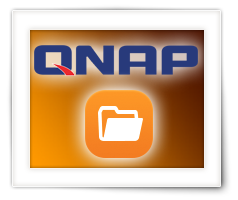
Occasionally I have those FTP jobs to either download or upload a truck load of files – for example when I want to make a backup of my website.
Now you could start a regular FTP client on your PC and have it run all night to do just that, or … you could use your QNAP for that – mine is running 24/7 anyway, so why not? The biggest issue is: where do you find a FTP client that can download or upload entire directory structures?
Download Station, and the likes, only take one URL at a time, or other apps do silly things like zipping all files before up- or download (who came up with THAT idea?).
After a long search I found something interesting; One of the best hidden features of File Station, the file manager in the web-interface of your QNAP, is the fact that it supports FTP … albeit poorly documented and hard to find … in this article: how do we do this with QTS 4 (tested with QTS 4.2.1). Note that this only supports regular FTP, so not SFTP!).
Ad Blocking Detected Please consider disabling your ad blocker for our website.
We rely on these ads to be able to run our website.
You can of course support us in other ways (see Support Us on the left).
When running Windows on your Mac through BootCamp, you might be searching for the CD/DVD Eject button every now and then, and back in the day (2009) I wrote a little application for that for my own use: BootCamp CD Eject.
This application works with all Windows version as of Windows XP – and you can use this without BootCamp as well.
This little application lives in the Windows Systray and allows you to eject a CD/DVD from a menu or through a key combination. There is also a key combination to quickly put your Windows in standby.
I’m posting the application (free!) since I recently ran into some users that actually had a use for it even 7 years after developing it.
As of today, version 1.6.1 of Name My TV Series has become available for Windows, MacOSX and Linux (32- and 64-bit).
This release fixes a bug with the import and export feature – which I overlooked when implementing AirDate.
Feel free leave a comment at the Rename your TV Series Files article, where you can also download the latest version.
ApplePi-Baker has been updated again.
This version addresses a potential issue with restoring large SD cards (sync kernel buffers), and compression when making backups of larger SD Cards.
The mechanism to “eject” and SD card has internally been revamped as well. Additional, the option “Auto Eject after Restore” has been implemented.
To show that ApplePi-Baker is still working, a small indicator has been placed in the upper right corner of the window.
Additionally the status refreshrate has been increased.
Visit the ApplePi-Baker article to download the latest version and to leave comments.
Ad Blocking Detected Please consider disabling your ad blocker for our website.
We rely on these ads to be able to run our website.
You can of course support us in other ways (see Support Us on the left).
For those of you writing articles or blog posts, you’ll find that it takes a lot of work to write a good article. Even a tiny post can take up a lot of time.
And what is the most annoying part? Folks just bluntly copying your work, without even asking or giving credit (there are a very few exceptions). It seems that the majority on the Internet is replicated that way. Copy, and Paste.
For WordPress users (and if you only take out the JavaScript part, this might work for others as well) can, with a little trick, automatically add a “source” link below what has been copied. Not only will this be a reminder for the “copier”, but (if left intact) a good way to boost SEO for your website.
When developing an application, sometimes it can be useful to offer the user a way to add this application to the LoginItems (Mac) or Autorun items (Windows), so that the application starts when MacOS X or Windows starts.
Since I have developed a couple applications for which this would be helpful, and as of lately even one for both platforms, I figured, why not place this in a unit so the code can be resused easily and quickly. Sharing the code would make life easier for others as well.
So here we are – feel free to post improvements – a unit that Adds, Removes and Checks if an application build with Lazarus Pascal, from the Loginitem/Autorun items.

Wake On Lan, the Ethernet standard for waking up (switching them ON) network enabled devices remotely, has (again) gained popularity, especially under NAS/Server users, who use their server or NAS only a few hours a day. Wether it’s to save on your Power bill, reduce your Carbon-Footprint, or to spare your equipment, Wake On Lan is here to stay …
Now come these question though,… how do I enable Wake On Lan on my network enabled device, and how do I send a “wake up” call to my device?
In this article, I’ll try to cover as much as I can – since it can be a pretty hairy process to setup Wake On Lan. It very strongly depends on the hardware and software capabilities of your device. Even though I cannot every device on the planet, I sure will try to help you get started with Wake On Lan.
Ad Blocking Detected Please consider disabling your ad blocker for our website.
We rely on these ads to be able to run our website.
You can of course support us in other ways (see Support Us on the left).
I had not used the good old Wake On LAN option in a while, until my brother-in-law (Jean-Pierre) was looking for something like that to wake up his NAS.
Most of the Wake On LAN applications I found for him were just too extensive, too complicated, or not free. I wanted just a simple menu in the System Tray (Windows: next to the clock, lower-left corner of your screen) or Menu-bar (MacOS X – top of your screen). Well, after quite a bit of searching I could not find anything suitable or to my liking and I decided to just write something myself.
Timing couldn’t be better, since I just wanted to implemented Wake On LAN in another application – ConnectMeNow (for MacOS X).
Reusing the code, making it suitable for Windows and MacOS X, and wrapping it in a small application was done relatively quickly.
This application has been tested under MacOS X 10.11 (El Capitan) and Windows 10 and it’s FREE.
ConnectMeNow, a small application for Mac OS X to quickly mount network shares, has been updated to version 1.7.
In this version a few things have been changed, like the SSH icon, so it’s easier to distinguish in the dropdown menu.
Support for NFS has been added – but has not been tested (I do not have a NFS share available to test).
Additionally Wake On Lan has been implemented, including support for a custom port number (default is 9) and retrieving the MAC Address automatically (for this the “server” needs to be powered on, connected, and in the local network). With that I’ve add a “timer” that will wait x seconds before mounting a volume that has been woken up with Wake On Lan.
For download of the latest version, please read the original article (Quickly connect Network shares on a Mac with ConnectMeNow), where you can also ask questions or report issues. Or … find the application on our Downloads Page.
Wouldn’t it be nice to have a widget to place an advertisement, for example from Google Adsense, into the sidebar of your WordPress website?
After all; the layout of your sidebar(s) could be managed from the WordPress admin pages, and allows you to place ads in the sidebar where and as many times as you see fit.
There are probably plenty plugins for this, but I dislike plugins.
So here the simple code for the “functions.php” that creates your own WordPress Ad Widget.
Ad Blocking Detected Please consider disabling your ad blocker for our website.
We rely on these ads to be able to run our website.
You can of course support us in other ways (see Support Us on the left).
Unfortunately, when running a website, some kind of income is needed to cover the hosting expenses. Often this is done by placing ads.
Like most other websites, even Tweaking4All has to resort to placing ads, although I’d rather have zero adds, but donations alone isn’t covering the costs.
The downside of ads, besides being annoying at times, is that they only generate revenue when placed strategically, so folks will click on them (hint!).
Now, I will not claim to be the right person to ask where you should place ads, but in my opinion there are 3 reasonably “good” locations.
At the beginning and end of an article, and … in the smack middle of an article.
In this article, I’ll show you how you can automatically have an ad placed in your content, on the fly. With this code you can place an ad just before the nth <H2> tag. We will not use a plugin, and the code is simply added to the “functions.php” file of your theme.
Some components in Lazarus Pascal (and Delphi), especially the ones that have a list of strings, allow you to add additional data by linking an object to a string. The function “AddObject” is often used for this, but it’s also the most overlooked option.
With this option you can link (add) any kind of data to rows in your string list, allowing you to add additional (non visual) data.
In this short article, I’ll show you how you can work with these objects, which allow you to extend the data stored with your lists.
As of today, version 1.6 of Name My TV Series has become available for Windows, MacOSX and Linux (32- and 64-bit).
This release fixes a bug with the “%S1” parameter, and adds an AirDate field (%AD) which can be used in filenames. Additionally, the file created/modified date can be set to the first air date as well.
Further more, “EPGuide” has been removed as a source, since TheTVDB usually provides better information, and “EPGuide” has proven to be unreliable when it comes to parsing data.
Feel free leave a comment at the Rename your TV Series Files article, where you can also download the latest version.
Ad Blocking Detected Please consider disabling your ad blocker for our website.
We rely on these ads to be able to run our website.
You can of course support us in other ways (see Support Us on the left).
I’ve been asked several times in the past, on how to take screenshot and annotate them afterwards, or how to do a so called “print-screen” to a printer for a hardcopy.
Some users, use screenshots for illustrating manuals, or articles for their website. Some use it to print error messages or odd things happening on their screen. And as with regular paper, some of us would like to annotate the images – add notes, comments, arrows, numbers or circle the important part of the image.
Annotating images is relatively easy, once you know where to find the tools to do this.
So in this article, for Mac OS X users: How to take screenshots, how to add annotations, and some additional related tips and tricks.

ConnectMeNow, a small application for Mac OS X to quickly mount network shares, has been updated to version 1.6.
In this version I have added the requirement to enter an admin password to reveal passwords.
This way the tool can be used on machines used by users who should not see the actual password in a safe manner.
Additionally, even though the implementation of SSH isn’t the best, I’ve increased the time-out for waiting for login information request by the server. Initially this was 1 second and has now been increased to 2 seconds. The 1 second wait worked just fine, however, slower servers, like a server outside of your home or business network, might take too long to respond. In those cases a higher time-out value proved easier to work with.
With the help of Whistle Master, I’ve been able to add WebDAV support as well.
A minor bug when entering the server alias name has been resolved as well.
And finally, you might have noticed it already, I’ve changed the App icon.
For download of the latest version, please read the original article (Quickly connect Network shares on a Mac with ConnectMeNow), where you can also ask questions or report issues. Or … find the application on our Downloads Page.







